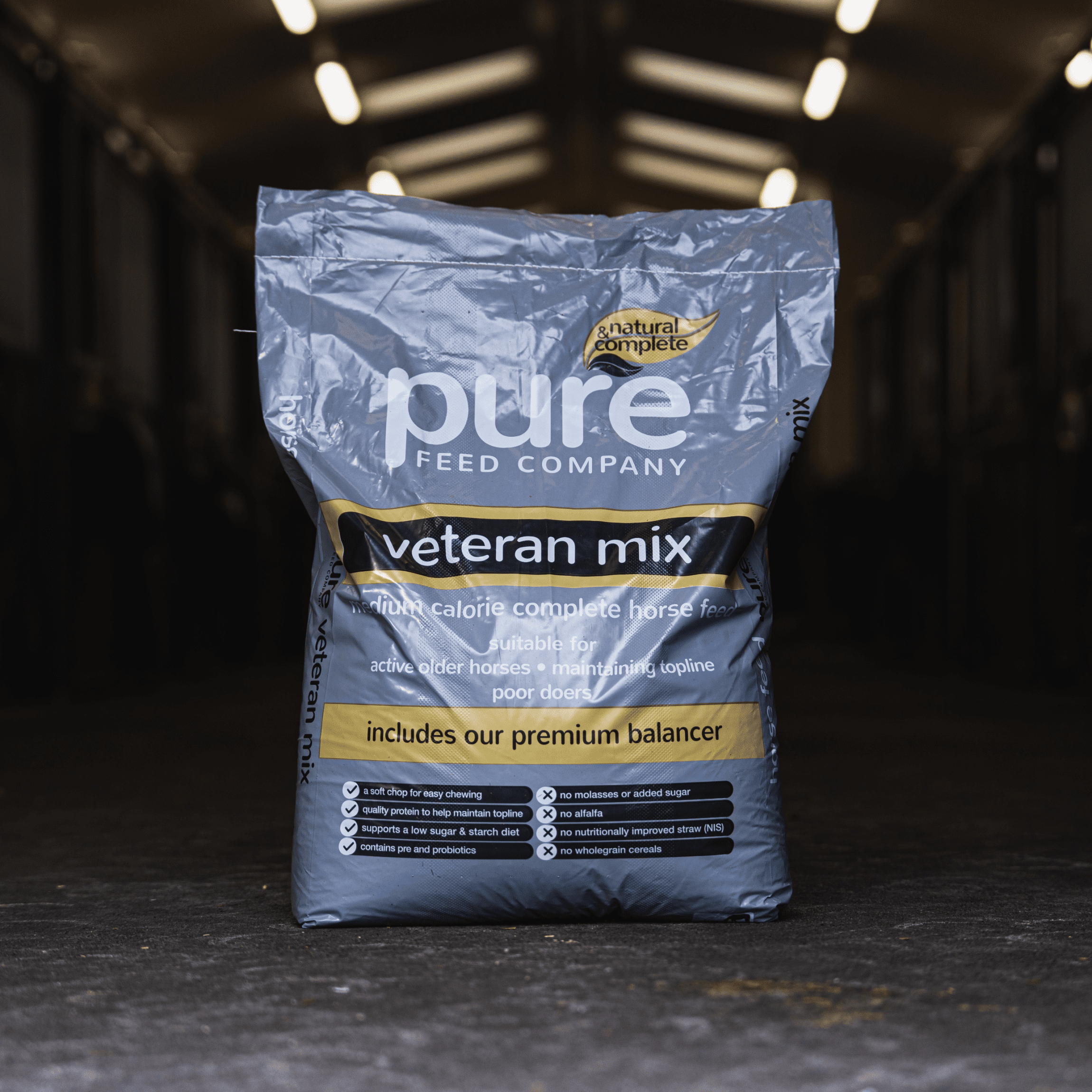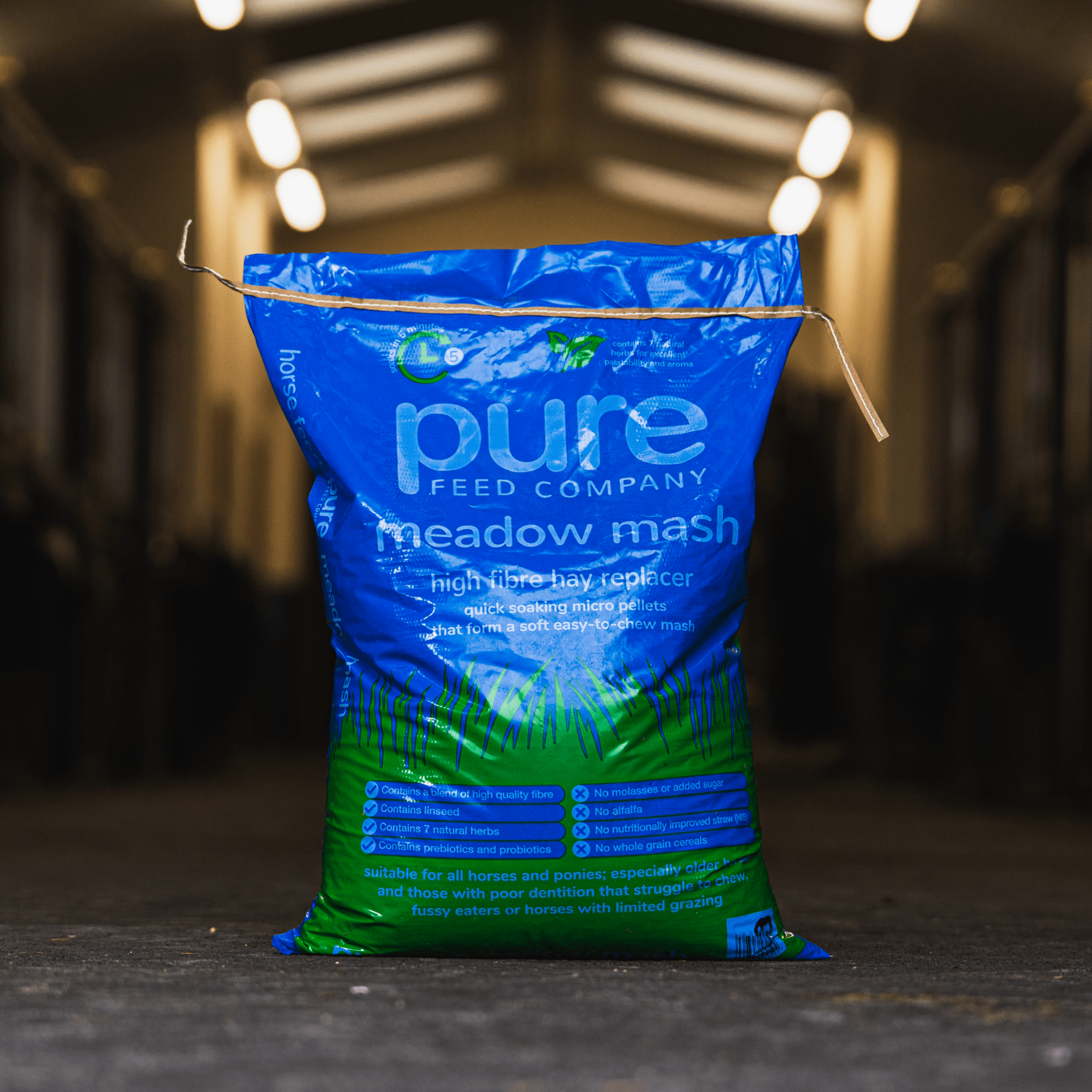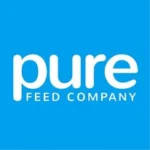FEED ADVICE – HEALTH
Equine Metabolic Syndrome: A Comprehensive Guide
Equine Metabolic Syndrome (EMS) is a complex condition affecting horses and ponies, characterized by insulin dysregulation and an increased risk of laminitis. Insulin dysregulation in EMS leads to abnormal responses to dietary carbohydrates, causing increased insulin secretion and elevated blood glucose levels. This imbalance can result in clinical signs such as obesity, regional fat deposition, infertility, and laminitis.
EMS is often seen in Native breeds such as Welsh, Dartmoor and Shetland ponies, as well as in certain horse breeds like Arabian and Warmbloods. However, it can affect horses of any breed or age.
Key Highlights

EMS involves insulin dysregulation and a high risk of laminitis, especially in ponies and overweight horses.

Risk factors include obesity, breed predisposition, and high-NSC diets (e.g., sugary/starchy feeds).

Signs include a cresty neck, fat pads, and recurrent laminitis.
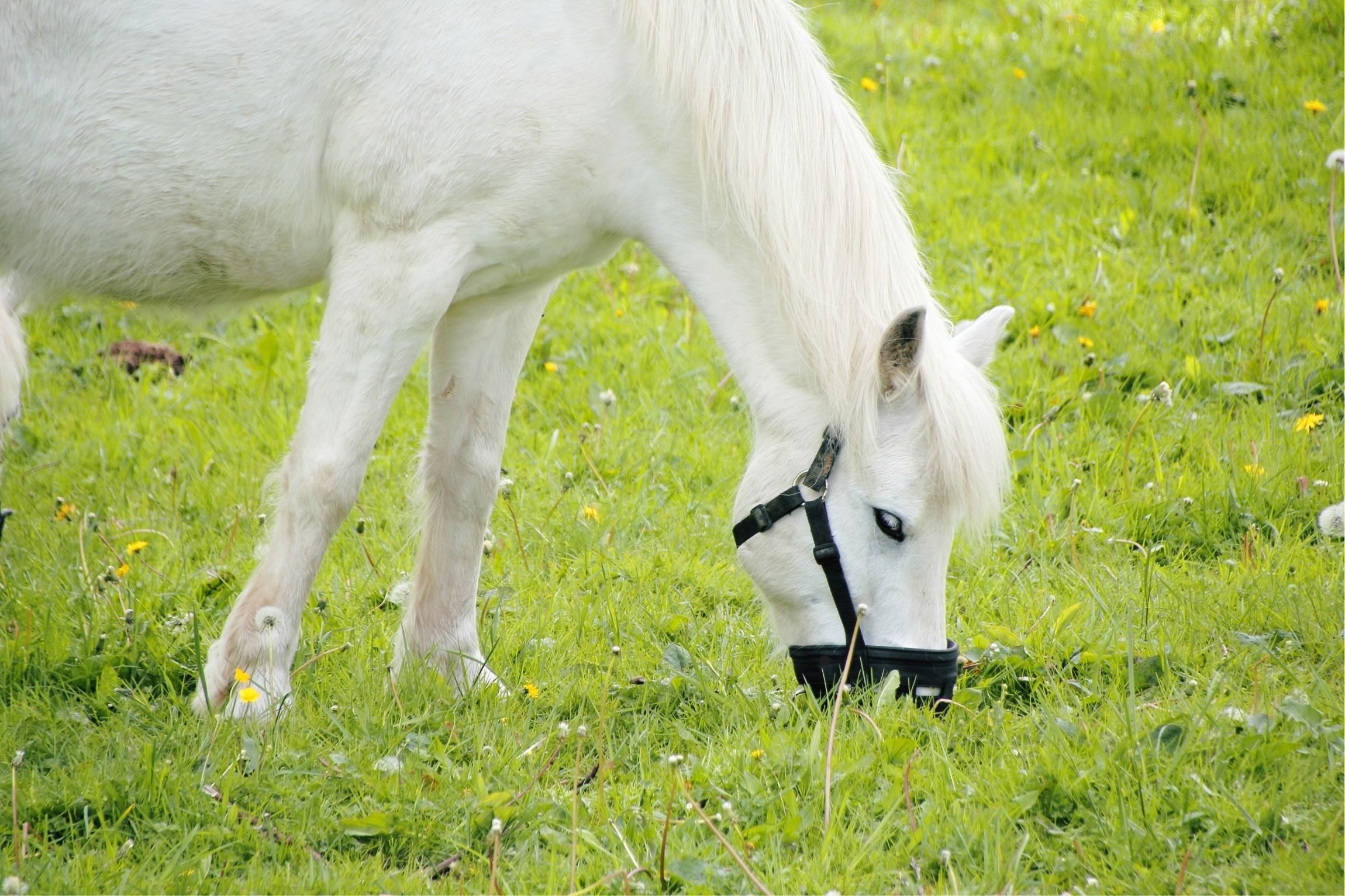
Management focuses on diet, weight loss, exercise, and vet care to reduce risks and support long-term wellbeing.
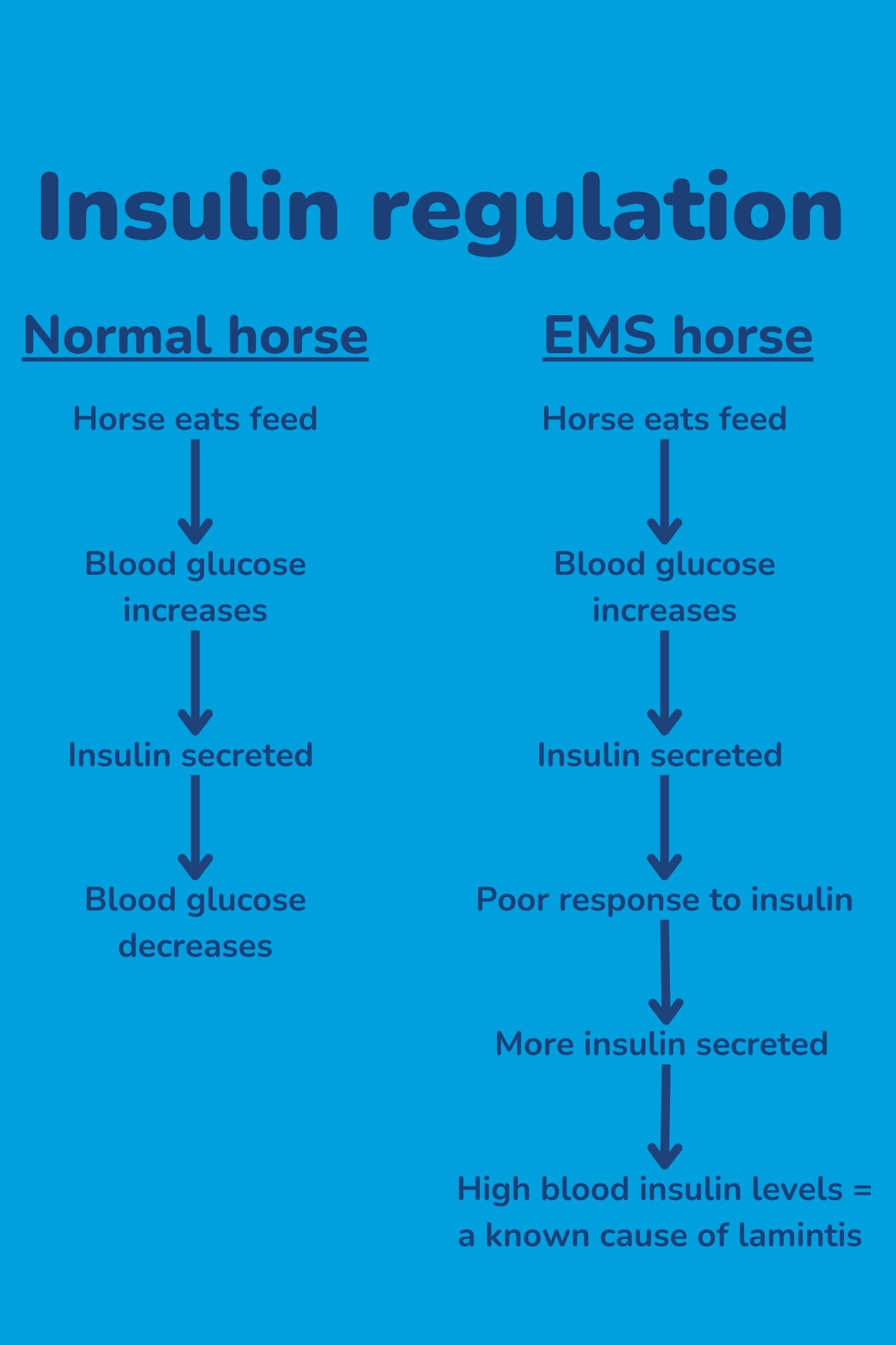
Understanding EMS
EMS is an endocrine disorder where horses struggle to regulate the release of insulin. In normal horses, insulin prompts tissue to absorb glucose after a meal. With EMS, fat deposits release hormones that interfere with tissue response to insulin, causing “insulin resistance”. The pancreas increases insulin release to counteract this, resulting in elevated insulin levels after meals and sometimes throughout the day. This mirrors metabolic issues in human type 2 diabetes.
Causes and Risk Factors of Equine Metabolic Syndrome (EMS)
Equine metabolic syndrome (EMS) has various causes and risk factors, including both genetic predisposition and environmental influences. While the exact underlying mechanisms are not fully understood, research suggests that EMS is a multifactorial condition with complex interactions between genetics, diet, and other factors.
Genetic Predisposition
Genetics play a significant role in the development of equine metabolic syndrome (EMS). Certain breeds, such as ponies, donkeys and Arabians, are more susceptible to EMS due to their genetic makeup. These breeds have evolved in harsh environments where resources were limited, leading to a higher efficiency in metabolizing dietary carbohydrates and storing energy.
Within these breeds, there may be individual horses with specific genetic factors that contribute to their inability to respond properly to dietary carbohydrates. These hereditary factors can result in insulin dysregulation and increased risk of developing EMS.
While genetic predisposition is a significant factor, it is essential to note that environmental influences and lifestyle factors also contribute to the development and progression of EMS. Therefore, a holistic approach that considers both genetic and environmental factors is necessary for managing EMS in horses.
Obesity
Obesity in horses can lead to Equine Metabolic Syndrome (EMS) primarily due to its role in promoting insulin resistance. Excess adipose tissue releases inflammatory substances and hormones, which interfere with insulin signalling pathways. This insulin resistance causes cells to become less responsive to insulin, leading to elevated insulin levels as the pancreas compensates. Chronic high insulin levels are a key feature of EMS and contribute to metabolic disturbances such as increased fat deposition.
Dietary Factors
Diets high in easily digestible carbohydrates, such as cereals and rich grass, can overwhelm the horse’s digestive system and lead to spikes in blood glucose levels. This frequent exposure to high-carbohydrate meals can result in insulin resistance over time, as the cells become less responsive to insulin’s signals to take up glucose. Consequently, the pancreas compensates by producing more insulin to regulate blood sugar levels, which can eventually lead to elevated insulin concentrations – a clinical sign of EMS.
Lack of Exercise
The lack of exercise contributes to EMS by reducing insulin sensitivity in horses. Regular physical activity is essential for maintaining insulin sensitivity by promoting glucose uptake into muscles, which helps regulate blood glucose levels effectively. Without adequate exercise, muscles become less responsive to insulin, leading to insulin resistance. This resistance prompts the pancreas to produce more insulin to compensate, eventually resulting in elevated insulin levels—a key characteristic of EMS. Additionally, sedentary horses are more prone to obesity as unused energy from feed is stored as fat, exacerbating insulin resistance and further increasing the risk of EMS.
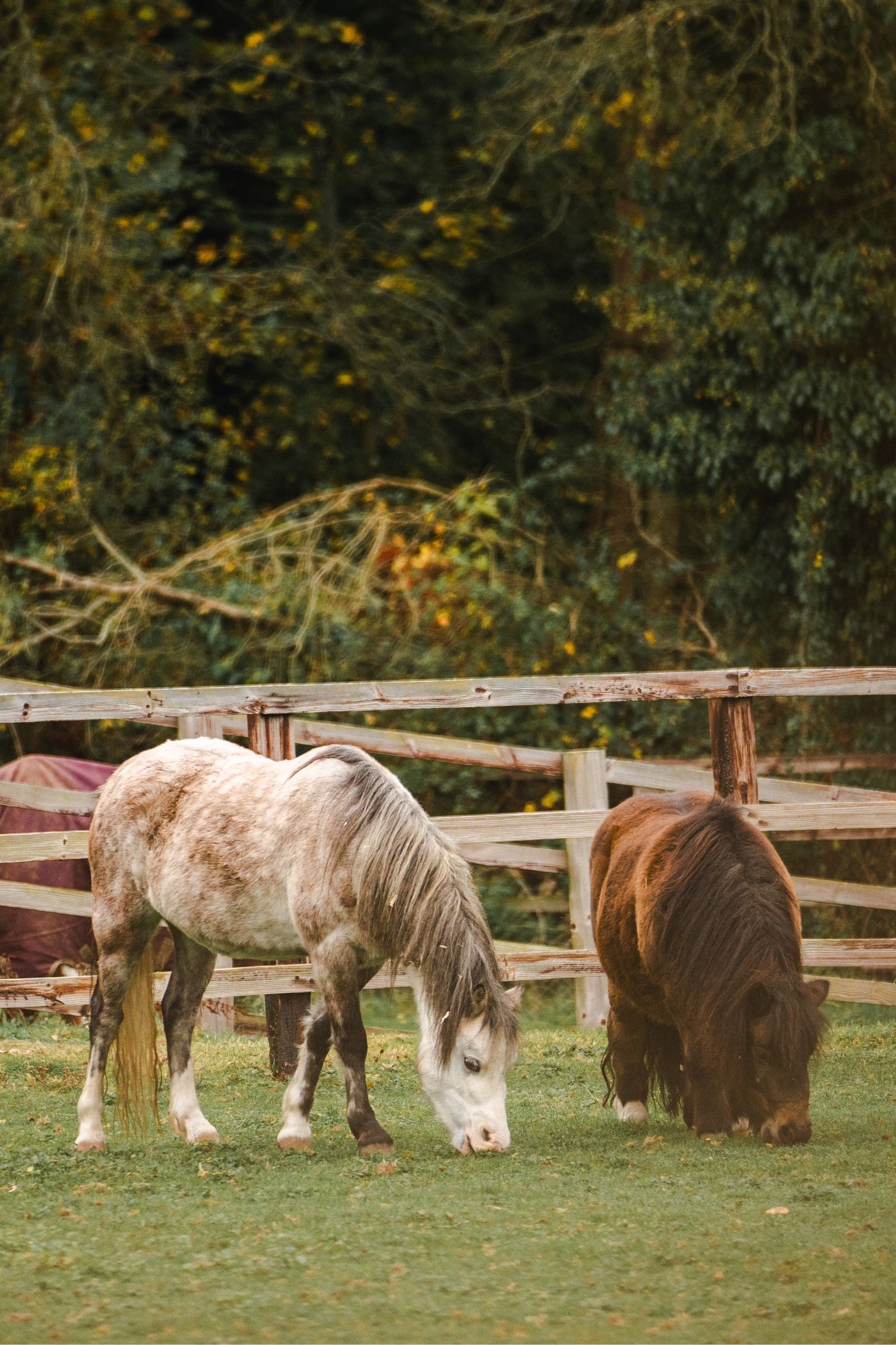
Recognising clinical signs of EMS
Recognising the clinical signs of EMS is crucial for early diagnosis and effective management. Here are some important symptoms to watch out for:
Management and Prevention Strategies
Exercise Strategies
Exercise plays a crucial role in managing EMS primarily by improving insulin sensitivity and promoting weight loss. Strategies include daily turnout in with controlled grazing, which encourages natural movement and reduces obesity risk. Incorporating regular sessions of walking, trotting, and occasional cantering helps improve cardiovascular fitness and muscle tone without undue stress on joints. Additional activities such as lunging, groundwork, hacking on varied terrain, and in-hand work with obstacles provide mental stimulation, enhance coordination, and promote muscle development. For horses needing low-impact options, swimming offers a beneficial alternative. It’s crucial to monitor each horse’s response, gradually increase exercise intensity to prevent injury.
While medications that improve insulin sensitivity are used in human metabolic syndrome, their efficacy in horses, such as metformin, remains uncertain due to absorption concerns. Various supplements like chromium, magnesium, cinnamon, and chasteberry extract have been suggested for EMS in horses, but current evidence does not support their efficacy, and their use cannot be recommended.
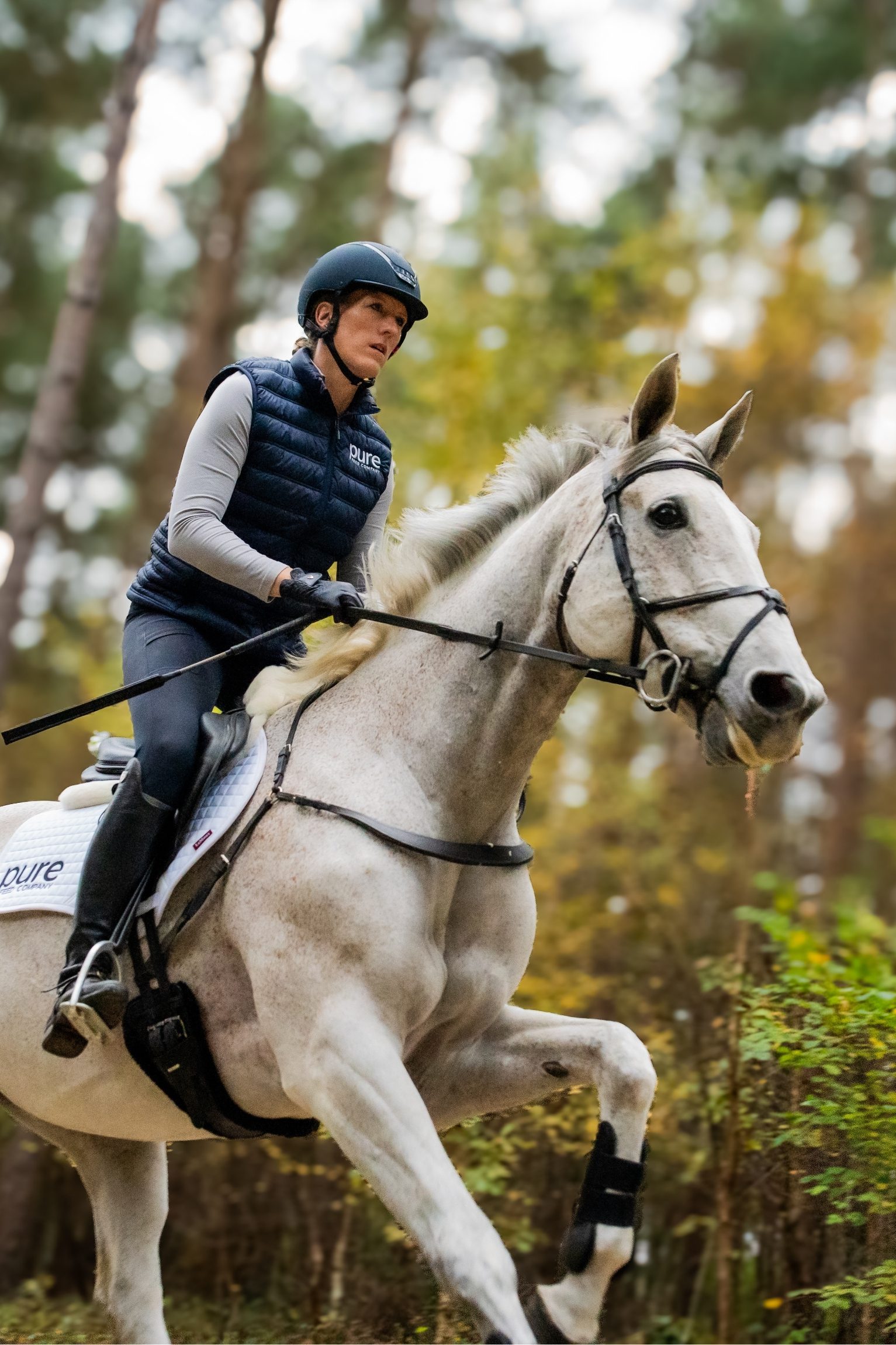
Diagnosis of EMS
Diagnosing EMS typically begins with an assessment based on the appearance of obesity and a history of laminitis. To confirm EMS and assess insulin resistance accurately, testing should be conducted after the horse has fasted and is not in pain or stressed (e.g., during a laminitis episode). Diagnostic methods include:
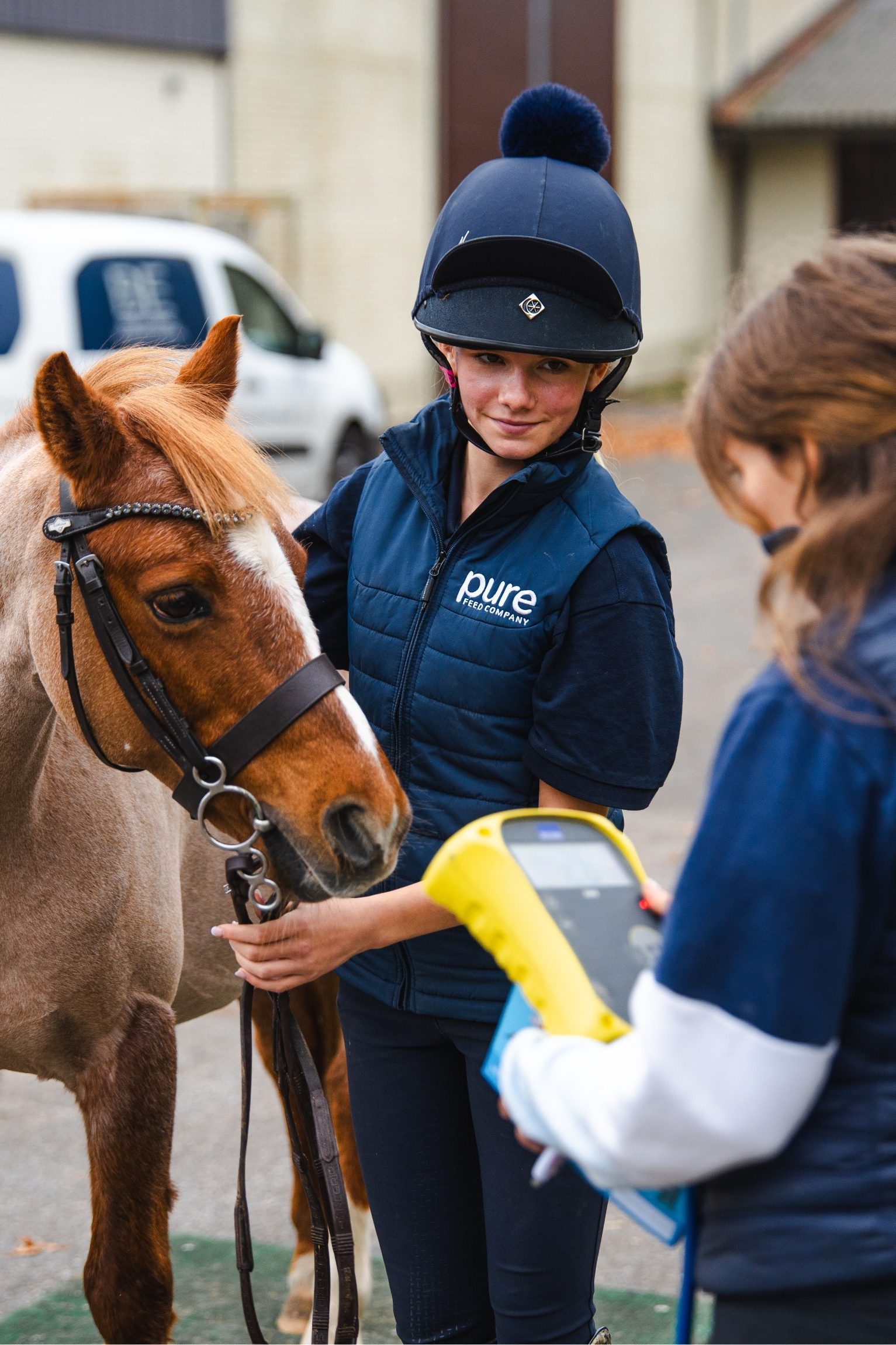
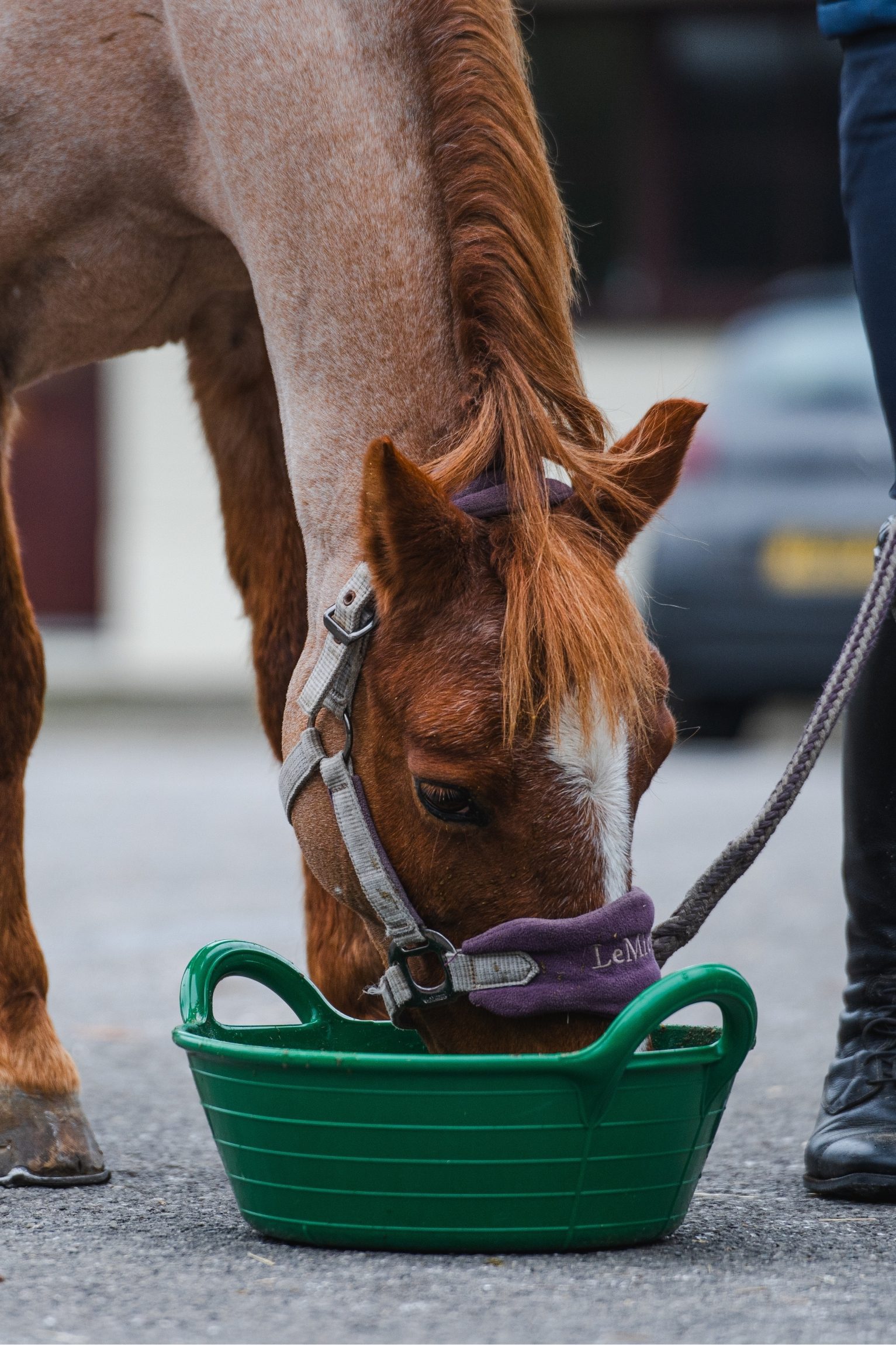
Dietary Strategies for a Horse with EMS
The key principles for preventing and treating Equine Metabolic Syndrome (EMS) are straightforward: implement dietary restriction and encourage regular exercise. These measures not only promote weight loss but also enhance overall fitness, improving insulin responsiveness.
Dietary Adjustments:
Did you know all of Pure Feed’s low calorie range is suitable for horses with EMS?
Limiting field access, especially during periods of lush growth such as Spring, helps control carbohydrate intake and prevent insulin spikes.
Did you know all of Pure Feeds complete feeds already contain a balancer! So already contain all of the essential nutrients required!
Omega-3 fatty acid supplementation, sourced from fish oil or linseed oil, may further reduce inflammation, improve insulin sensitivity, and enhance cardiovascular function in horses with EMS.
Pure Linseed is a great source of Omega 3 – and a little goes a long way! Check it out here
Managing insulin spikes with strategies like feeding frequent small meals helps promotes stable blood glucose levels, contributing to effective EMS management.
Consider weight loss strategies such as using a grazing muzzle, soaking hay and triple netting to help control obesity.
Conclusion
In conclusion, managing EMS requires a well-rounded approach. Early recognition of clinical symptoms, like obesity and recurrent laminitis is key for timely treatment. Effective management includes providing a low-NSC (non-structural carbohydrate) diet, limiting field access, ensuring a balanced intake of essential nutrients, and supplementing with omega-3 fatty acids. Regular, appropriate exercise enhances insulin sensitivity and aids in weight loss. Consistent monitoring and veterinary guidance are essential to prevent complications like laminitis and to improve the horse’s overall health.
What we recommend for horses with EMS
Made in the UK
We are proud to say that all of our feeds are produced here in the UK
FREE Shipping
We offer FREE SHIPPING for all orders in the UK with 15 bags and over*
Sustainable
We are dedicated to playing our part in making the world more sustainable

100% Natural
We use high-quality ingredients and no unnecessary additives.
Thousands of people love our feeds
Why Veteran feeds are different 👴
As horses age, their bodies change, and so do their nutritional needs. That’s why our Veteran range is formulated differently from our standard feeds:
🔬 Fibre: softer chaff in the Mix, and pellets that soak into a mash, making them easier to chew and digest.
🔬 Protein: higher levels to support muscle maintenance, as older horses can lose muscle tone more easily.
🔬 Balancer: extra vitamins and minerals to compensate for reduced digestive efficiency.

Why Veteran feeds are different 👴
As horses age, their bodies change, and so do their nutritional needs. That’s why our Veteran range is formulated differently from our standard feeds:
🔬 Fibre: softer chaff in the Mix, and pellets that soak into a mash, making them easier to chew and digest.
🔬 Protein: higher levels to support muscle maintenance, as older horses can lose muscle tone more easily.
🔬 Balancer: extra vitamins and minerals to compensate for reduced digestive efficiency.
Did you know we make a pelleted feed specifically for older horses? Pure Veteran Pellets make it easy:
🌾 Soft & soakable so easy on worn teeth
⚡ Slow-release energy from fibre & oil
🧪 Built-in vitamin & mineral balancer specifically for older horses
💚 Gut-friendly for maximum nutrient absorption
✅ Complete feed, so no extra supplements needed

Did you know we make a pelleted feed specifically for older horses? Pure Veteran Pellets make it easy:
🌾 Soft & soakable so easy on worn teeth
⚡ Slow-release energy from fibre & oil
🧪 Built-in vitamin & mineral balancer specifically for older horses
💚 Gut-friendly for maximum nutrient absorption
✅ Complete feed, so no extra supplements needed
Ever wondered what the Pure Feed team use with their own horses? Meet Tara, Elise (Head of Nutrition ) Irish Sport Horse.
Since arriving three years ago, Tara has been fed on Pure Balance. She’s a classic good doer with plenty of natural energy, so Pure Balance provides everything she needs without unnecessary calories or any fizz. Elise always jokes that the only part of Tara that’s ID is her ability to gain weight … and the mountain of hair she grows each winter!
Despite being in full work and competing up to BE Novice and BS Foxhunter, Pure Balance supplies all the vitamins and minerals Tara needs. It’s a great reminder that the label on a feed bag is a guide, not a rulebook - the right choice depends on the horse in front of you!
Wondering which Pure Feed is the right choice for your horse? Our free diet plan tool can help! Click the link in our bio to start 🌱
#purefeed #thepurefeedcompany #equinenutrition #allyoufeedislove #dietplan

Ever wondered what the Pure Feed team use with their own horses? Meet Tara, Elise (Head of Nutrition ) Irish Sport Horse.
Since arriving three years ago, Tara has been fed on Pure Balance. She’s a classic good doer with plenty of natural energy, so Pure Balance provides everything she needs without unnecessary calories or any fizz. Elise always jokes that the only part of Tara that’s ID is her ability to gain weight … and the mountain of hair she grows each winter!
Despite being in full work and competing up to BE Novice and BS Foxhunter, Pure Balance supplies all the vitamins and minerals Tara needs. It’s a great reminder that the label on a feed bag is a guide, not a rulebook - the right choice depends on the horse in front of you!
Wondering which Pure Feed is the right choice for your horse? Our free diet plan tool can help! Click the link in our bio to start 🌱
#purefeed #thepurefeedcompany #equinenutrition #allyoufeedislove #dietplan
Do you know how much your horse actually weighs?
There are a few different ways to find out:
• Weighbridge – the most accurate method.
• Weigh tape – handy and affordable, but results can vary.
• Measurements & calculations – a useful estimate if no other tools are available.
👉 Knowing your horse’s weight can help you:
• Feed the correct daily ration
• Dose wormers accurately
• Track changes in condition over time, for example, spotting weight loss before it’s obvious.
However, weight isn’t the whole picture. A horse’s health and performance are better reflected by a combination of weight, body condition scoring, and muscle tone. A fit eventer and a good doer native might weigh the same but look very different!
📏 Do you regularly weigh your horse or use a weigh tape?
#purefeed #thepurefeedcompany #allyoufeedislove #equinenutrition

Do you know how much your horse actually weighs?
There are a few different ways to find out:
• Weighbridge – the most accurate method.
• Weigh tape – handy and affordable, but results can vary.
• Measurements & calculations – a useful estimate if no other tools are available.
👉 Knowing your horse’s weight can help you:
• Feed the correct daily ration
• Dose wormers accurately
• Track changes in condition over time, for example, spotting weight loss before it’s obvious.
However, weight isn’t the whole picture. A horse’s health and performance are better reflected by a combination of weight, body condition scoring, and muscle tone. A fit eventer and a good doer native might weigh the same but look very different!
📏 Do you regularly weigh your horse or use a weigh tape?
#purefeed #thepurefeedcompany #allyoufeedislove #equinenutrition
Just because it’s cold doesn’t mean your horse isn’t sweating!
Recovery mashes aren`t just a summer gimmick; winter training pushes muscles, burns energy, and makes your horse lose vital nutrients, just like in summer. Your horse still loses essential electrolytes in sweat, muscles still burn, and the whole body is working hard.
Pure Refuel is formulated to give your horse the support they need after training hard:
Electrolytes to replace what sweat takes out and keep hydration balanced.
Antioxidants to combat exercise-induced stress and speed recovery.
Key amino acids to maintain muscle, support strength, and keep your horse in peak condition.
Plus Refuel tastes irresitble, soaks in 5 minutes, and is suitable for horses with EMS, ulcers and Cushings! 🍒
#allyoufeedislove #purefeed #thepurefeedcompany #equinenutrition

Just because it’s cold doesn’t mean your horse isn’t sweating!
Recovery mashes aren`t just a summer gimmick; winter training pushes muscles, burns energy, and makes your horse lose vital nutrients, just like in summer. Your horse still loses essential electrolytes in sweat, muscles still burn, and the whole body is working hard.
Pure Refuel is formulated to give your horse the support they need after training hard:
Electrolytes to replace what sweat takes out and keep hydration balanced.
Antioxidants to combat exercise-induced stress and speed recovery.
Key amino acids to maintain muscle, support strength, and keep your horse in peak condition.
Plus Refuel tastes irresitble, soaks in 5 minutes, and is suitable for horses with EMS, ulcers and Cushings! 🍒
#allyoufeedislove #purefeed #thepurefeedcompany #equinenutrition
As horses get older, their digestion slows down. This can mean:
⚠️ Harder to get nutrients from forage
⚠️ Weight loss & reduced topline
⚠️ Deficiencies in key vitamins & minerals
Teeth wear and reduced gut efficiency make it even trickier.
👉 That’s where Pure Veteran Mix comes in:
✅ Highly digestible fibre & oil for slow-release energy
✅ Built-in balancer with essential vitamins & minerals
✅ Gut balancer to optimise digestion
✅ Soft, easy-to-chew pellets for worn teeth
💡 It’s a complete feed, no extra supplements needed. Just feed alongside forage and help your older horse stay strong, shiny, and comfortable into their senior years.

As horses get older, their digestion slows down. This can mean:
⚠️ Harder to get nutrients from forage
⚠️ Weight loss & reduced topline
⚠️ Deficiencies in key vitamins & minerals
Teeth wear and reduced gut efficiency make it even trickier.
👉 That’s where Pure Veteran Mix comes in:
✅ Highly digestible fibre & oil for slow-release energy
✅ Built-in balancer with essential vitamins & minerals
✅ Gut balancer to optimise digestion
✅ Soft, easy-to-chew pellets for worn teeth
💡 It’s a complete feed, no extra supplements needed. Just feed alongside forage and help your older horse stay strong, shiny, and comfortable into their senior years.
Worried about fireworks this autumn? Here are our top tips:
1. Plan Ahead
Check local fireworks schedules and speak with neighbours or your council to know when displays are expected. Planning turnout, stabling, and feeding around these dates can reduce stress.
2. Create a Safe Environment
If possible, move your horse away from fireworks. Check fencing and your fields for hazards. For stabled horses, ensure the stable is secure, ventilated, and free from sharp objects. Leaving boots on overnight can help protect legs.
3. Distraction is Key
Keep horses occupied with ample forage, toys, or treat balls. Pure Meadow Mash or Pure Treats in a treat ball can be fed in larger portions to distract and comfort horses. Soft background sounds, like classical music or nature tracks, can help mask fireworks.
4. Use Calming Products Wisely
Discuss with your vet about calming supplements such as magnesium or herbal remedies. Pheromone sprays can also reduce stress by mimicking natural calming signals.
5. Maintain Consistent Routines
Stick to normal feeding, turnout, and exercise schedules. Familiarity is reassuring. Leaving a light on in the stable can help reduce the impact of flashing fireworks.
6. Stay Calm and Reassuring
Horses pick up on handler emotions. Stay relaxed, use gentle strokes, and avoid loud voices or sudden movements. Remember that frightened horses can act unpredictably.
7. Observe and Adapt
Each horse reacts differently. Some may benefit from early feeding, others from larger soaked fibre portions before fireworks start. Adjust based on behaviour and stress levels.
8. Consult a Professional if Needed
If your horse shows severe anxiety, speak to your vet as they can offer alternative solutions to help keep your horse calm.

Worried about fireworks this autumn? Here are our top tips:
1. Plan Ahead
Check local fireworks schedules and speak with neighbours or your council to know when displays are expected. Planning turnout, stabling, and feeding around these dates can reduce stress.
2. Create a Safe Environment
If possible, move your horse away from fireworks. Check fencing and your fields for hazards. For stabled horses, ensure the stable is secure, ventilated, and free from sharp objects. Leaving boots on overnight can help protect legs.
3. Distraction is Key
Keep horses occupied with ample forage, toys, or treat balls. Pure Meadow Mash or Pure Treats in a treat ball can be fed in larger portions to distract and comfort horses. Soft background sounds, like classical music or nature tracks, can help mask fireworks.
4. Use Calming Products Wisely
Discuss with your vet about calming supplements such as magnesium or herbal remedies. Pheromone sprays can also reduce stress by mimicking natural calming signals.
5. Maintain Consistent Routines
Stick to normal feeding, turnout, and exercise schedules. Familiarity is reassuring. Leaving a light on in the stable can help reduce the impact of flashing fireworks.
6. Stay Calm and Reassuring
Horses pick up on handler emotions. Stay relaxed, use gentle strokes, and avoid loud voices or sudden movements. Remember that frightened horses can act unpredictably.
7. Observe and Adapt
Each horse reacts differently. Some may benefit from early feeding, others from larger soaked fibre portions before fireworks start. Adjust based on behaviour and stress levels.
8. Consult a Professional if Needed
If your horse shows severe anxiety, speak to your vet as they can offer alternative solutions to help keep your horse calm.
Wishing you and your horses a spook-tacular Halloween from all of us here at The Pure Feed Company!
Let us know what you`re doing to celebrate in the comments below ⬇️
#thepurefeedcompany #purefeed #happyhalloween

Wishing you and your horses a spook-tacular Halloween from all of us here at The Pure Feed Company!
Let us know what you`re doing to celebrate in the comments below ⬇️
#thepurefeedcompany #purefeed #happyhalloween
With Halloween coming up, may horse owners want to know "Can Horses Eat Pumpkins?" 🎃
Want your horse to join in the Halloween fun? Or perhaps you have a few pumpkins going spare after carving. But yes, your horse can eat pumpkin! Pumpkins are mostly water and fibre, low in starch, and packed with beta-carotene (a pro-vitamin A). ✅ That makes them a crunchy, gut-friendly snack!
But seeds in huge quantities can be difficult for your horse to digest! We recommend cutting up a few chunks of the Pumpkin and feeding it seed free.
Got a question regarding equine nutrition? Leave it in the comments, we would be more than happy to help 😊
#thepurefeedcompany #purefeed #halloween #faq

With Halloween coming up, may horse owners want to know "Can Horses Eat Pumpkins?" 🎃
Want your horse to join in the Halloween fun? Or perhaps you have a few pumpkins going spare after carving. But yes, your horse can eat pumpkin! Pumpkins are mostly water and fibre, low in starch, and packed with beta-carotene (a pro-vitamin A). ✅ That makes them a crunchy, gut-friendly snack!
But seeds in huge quantities can be difficult for your horse to digest! We recommend cutting up a few chunks of the Pumpkin and feeding it seed free.
Got a question regarding equine nutrition? Leave it in the comments, we would be more than happy to help 😊
#thepurefeedcompany #purefeed #halloween #faq
Not sure if your horse is getting exactly what they need from their feed? 🩵
Every horse is different - from workload and temperament to medical history and grazing - so there’s no such thing as a one-size-fits-all diet. That’s why a personalised feeding plan can make all the difference.
📋 Whether your goal is to build top line, maintain weight, support performance, or manage a condition - we can help you get there.
💬 Comment “DIET PLAN” below or click the link in our bio to start your free, tailored feeding plan today.
#thepurefeedcompany #purefeed #dietplan #equinenutrition

Not sure if your horse is getting exactly what they need from their feed? 🩵
Every horse is different - from workload and temperament to medical history and grazing - so there’s no such thing as a one-size-fits-all diet. That’s why a personalised feeding plan can make all the difference.
📋 Whether your goal is to build top line, maintain weight, support performance, or manage a condition - we can help you get there.
💬 Comment “DIET PLAN” below or click the link in our bio to start your free, tailored feeding plan today.
#thepurefeedcompany #purefeed #dietplan #equinenutrition
🎃 Trick or Treat… But Watch Out for Hidden Sugars!
Halloween is here, and your horse might be expecting a few treats. But beware… not all treats are as innocent as they look. Some hide sinister sugars under friendly names like molasses, glucose syrup or cane sugar!
Why care? These sneaky sugars are non-structural carbohydrates (NSC), which can spike blood glucose and insulin. For sugar-sensitive horses, ponies prone to laminitis, or those with EMS or Cushing’s, that’s a recipe for a very scary vet bill. 💀
Molasses is especially sneaky: sweet, sticky, and rapidly fermentable in the hindgut. Too much, and it can disrupt digestion, alter gut microbes, and even cause colic.
Pure Feed treats, on the other hand, are all treat and no trick. Low-starch, fibre-rich, and free from hidden sugars, they support the hindgut function while still being delicious!
You can find out more about Pure Treats on our website!
#thepurefeedcompany #purefeed #equinenutrition

🎃 Trick or Treat… But Watch Out for Hidden Sugars!
Halloween is here, and your horse might be expecting a few treats. But beware… not all treats are as innocent as they look. Some hide sinister sugars under friendly names like molasses, glucose syrup or cane sugar!
Why care? These sneaky sugars are non-structural carbohydrates (NSC), which can spike blood glucose and insulin. For sugar-sensitive horses, ponies prone to laminitis, or those with EMS or Cushing’s, that’s a recipe for a very scary vet bill. 💀
Molasses is especially sneaky: sweet, sticky, and rapidly fermentable in the hindgut. Too much, and it can disrupt digestion, alter gut microbes, and even cause colic.
Pure Feed treats, on the other hand, are all treat and no trick. Low-starch, fibre-rich, and free from hidden sugars, they support the hindgut function while still being delicious!
You can find out more about Pure Treats on our website!
#thepurefeedcompany #purefeed #equinenutrition
How do I choose the right calorie level for my horse? 🤷
To get this right, it helps to look at the numbers.
Baseline energy needs ⚡️
An average 500 kg horse at rest needs around 65–70 MJ (megajoules) of digestible energy (DE) per day just to maintain bodyweight.
Add light work (e.g. hacking 3–4 times a week), and this rises to 75–85 MJ/day.
Moderate work (e.g. regular schooling, low-level eventing) pushes it to 90–100 MJ/day.
Harder workloads (e.g. advanced eventing, racing) can exceed 120 MJ/day.
Winter factor ❄️
Once temperatures dip below the horse’s lower critical temperature (around 0–5°C for a horse with a winter coat), requirements increase by ~2–2.5% for every degree drop. That means on a frosty night at –5°C, a horse may need an extra 15–20 MJ/day simply for staying warm.
What does that look like in feed?🐎
Grass (summer grazing): Good grass provides ~10 MJ DE per kg of dry matter. A horse can easily meet 80–100 MJ/day on grass alone.
Hay: Average meadow hay sits around 7–9 MJ DE per kg of dry matter. To meet 80 MJ, a horse would need 9–11 kg of hay (dry weight) daily, which is achievable but often limited by hay quality or feeding practices.
Why does this matter? 🤔
If the diet falls short, the horse mobilises fat (and eventually muscle) to make up the difference, which is why condition loss is so common in winter. On the other hand, oversupplying calories can lead to unwanted weight gain and metabolic strain in good doers.
How Pure Feed helps 🩵
Because our complete feeds combine fibre, oil, and a full balancer in every bag, they deliver calories in the same slow-release form the horse’s gut evolved to use. That means:
You can top up forage rations with controlled calories.
You know vitamins and minerals are always covered.
You can choose the right calorie level across our range, from Pure Easy for good doers to Pure Condition Mix for horses needing more support. With no hidden ingredients, preservatives or molasses, there`s a Pure Feed for your horse.
#thepurefeedcompany #purefeed #allyoufeedislove #equinenutrition

How do I choose the right calorie level for my horse? 🤷
To get this right, it helps to look at the numbers.
Baseline energy needs ⚡️
An average 500 kg horse at rest needs around 65–70 MJ (megajoules) of digestible energy (DE) per day just to maintain bodyweight.
Add light work (e.g. hacking 3–4 times a week), and this rises to 75–85 MJ/day.
Moderate work (e.g. regular schooling, low-level eventing) pushes it to 90–100 MJ/day.
Harder workloads (e.g. advanced eventing, racing) can exceed 120 MJ/day.
Winter factor ❄️
Once temperatures dip below the horse’s lower critical temperature (around 0–5°C for a horse with a winter coat), requirements increase by ~2–2.5% for every degree drop. That means on a frosty night at –5°C, a horse may need an extra 15–20 MJ/day simply for staying warm.
What does that look like in feed?🐎
Grass (summer grazing): Good grass provides ~10 MJ DE per kg of dry matter. A horse can easily meet 80–100 MJ/day on grass alone.
Hay: Average meadow hay sits around 7–9 MJ DE per kg of dry matter. To meet 80 MJ, a horse would need 9–11 kg of hay (dry weight) daily, which is achievable but often limited by hay quality or feeding practices.
Why does this matter? 🤔
If the diet falls short, the horse mobilises fat (and eventually muscle) to make up the difference, which is why condition loss is so common in winter. On the other hand, oversupplying calories can lead to unwanted weight gain and metabolic strain in good doers.
How Pure Feed helps 🩵
Because our complete feeds combine fibre, oil, and a full balancer in every bag, they deliver calories in the same slow-release form the horse’s gut evolved to use. That means:
You can top up forage rations with controlled calories.
You know vitamins and minerals are always covered.
You can choose the right calorie level across our range, from Pure Easy for good doers to Pure Condition Mix for horses needing more support. With no hidden ingredients, preservatives or molasses, there`s a Pure Feed for your horse.
#thepurefeedcompany #purefeed #allyoufeedislove #equinenutrition
Why do so many horses drop weight in winter? ❄️ Let us tell you why ...
🔥 Colder temps = more calories needed
Once it’s below 0–5°C, your horse needs extra energy just to stay warm. If their diet doesn’t cover it, they’ll burn fat reserves instead.
🌾 Forage isn’t as rich as summer grass
Hay and haylage have less energy & fewer vitamins than fresh grass, even if the net looks full.
🦠 Gut microbes have to adapt
Switching from grass to hay changes the gut bacteria, meaning they might get less usable energy from the same amount of forage.
💨 Energy goes to heat, not weight
More calories are spent on staying warm, especially if they’re still in work.
🏠 Routine changes matter
Less turnout, more stabling, and longer gaps between meals can all affect digestion & condition.
What helps?
✔️ Ad-lib forage to keep the gut working & generating heat
✔️ Slow-release calories from unmolassed beet, grass fibres or oil
✔️ Vitamin & mineral balance to make up for forage shortfalls
✔️ Check body condition every 2–3 weeks
Our complete feeds are designed to tackle exactly these winter challenges. Each one provides:
✅ Fibre for gut support and heat generation
✅ Oil for steady, slow-release energy
✅ A full balancer with vitamins and minerals (no extra bucket needed!)
So even when winter forage is variable, you know your horse’s diet is still balanced — and their condition is supported right through to spring.
To find the right feed for your horse, head on over to www.purefeed.com to claim your FREE personalised diet plan, created by our nutrition team 🩵
#thepurefeedcompany #purefeed #equinenutrition #allyoufeedislove

Why do so many horses drop weight in winter? ❄️ Let us tell you why ...
🔥 Colder temps = more calories needed
Once it’s below 0–5°C, your horse needs extra energy just to stay warm. If their diet doesn’t cover it, they’ll burn fat reserves instead.
🌾 Forage isn’t as rich as summer grass
Hay and haylage have less energy & fewer vitamins than fresh grass, even if the net looks full.
🦠 Gut microbes have to adapt
Switching from grass to hay changes the gut bacteria, meaning they might get less usable energy from the same amount of forage.
💨 Energy goes to heat, not weight
More calories are spent on staying warm, especially if they’re still in work.
🏠 Routine changes matter
Less turnout, more stabling, and longer gaps between meals can all affect digestion & condition.
What helps?
✔️ Ad-lib forage to keep the gut working & generating heat
✔️ Slow-release calories from unmolassed beet, grass fibres or oil
✔️ Vitamin & mineral balance to make up for forage shortfalls
✔️ Check body condition every 2–3 weeks
Our complete feeds are designed to tackle exactly these winter challenges. Each one provides:
✅ Fibre for gut support and heat generation
✅ Oil for steady, slow-release energy
✅ A full balancer with vitamins and minerals (no extra bucket needed!)
So even when winter forage is variable, you know your horse’s diet is still balanced — and their condition is supported right through to spring.
To find the right feed for your horse, head on over to www.purefeed.com to claim your FREE personalised diet plan, created by our nutrition team 🩵
#thepurefeedcompany #purefeed #equinenutrition #allyoufeedislove
🚫 STOP FEEDING SUPERMARKET OILS ‼️
Adding vegetable oil for extra condition or coat shine might seem harmless — but the fatty acid balance is all wrong for horses.
🔸 Horses need both omega-3 (ALA) and omega-6 (LA) — but the ratio is what matters.
Here’s how common oils stack up against grass 👇
🌿 Grass ≈ 3–4:1 (omega-3:omega-6)
🌱 Linseed ≈ 4:1
🥥 Coconut ≈ 1:2
🌰 Soya ≈ 1:7
🌽 Corn ≈ 1:50
🌻 Sunflower ≈ 1:200
An excess of omega-6 can:
❌ Increase pro-inflammatory compounds
❌ Slow recovery after exercise
❌ Exacerbate gut sensitivity
❌ Add strain to joints
✨ Linseed is naturally rich in omega-3, helping restore balance in hay- and cereal-based diets. It supports anti-inflammatory pathways, a glossy coat, healthy skin, and cell function.
💜 Pure Linseed is 100% micronised linseed — highly digestible, naturally high in oil for slow-release energy, a great fibre source, and close to the horse’s natural omega ratio.
👉 Head to our website to learn more about Pure Linseed.
#purefeed #thepurefeedcompany #purelinseed

🚫 STOP FEEDING SUPERMARKET OILS ‼️
Adding vegetable oil for extra condition or coat shine might seem harmless — but the fatty acid balance is all wrong for horses.
🔸 Horses need both omega-3 (ALA) and omega-6 (LA) — but the ratio is what matters.
Here’s how common oils stack up against grass 👇
🌿 Grass ≈ 3–4:1 (omega-3:omega-6)
🌱 Linseed ≈ 4:1
🥥 Coconut ≈ 1:2
🌰 Soya ≈ 1:7
🌽 Corn ≈ 1:50
🌻 Sunflower ≈ 1:200
An excess of omega-6 can:
❌ Increase pro-inflammatory compounds
❌ Slow recovery after exercise
❌ Exacerbate gut sensitivity
❌ Add strain to joints
✨ Linseed is naturally rich in omega-3, helping restore balance in hay- and cereal-based diets. It supports anti-inflammatory pathways, a glossy coat, healthy skin, and cell function.
💜 Pure Linseed is 100% micronised linseed — highly digestible, naturally high in oil for slow-release energy, a great fibre source, and close to the horse’s natural omega ratio.
👉 Head to our website to learn more about Pure Linseed.
#purefeed #thepurefeedcompany #purelinseed
Feeding Rates of Pure Sud explained ... Swipe to see how much Stud your horse should be eating ➡️
Why Pure Stud:
🩷 Supports sound bone development.🩷 Low starch content encourages positive behaviour.
🩷 Great value way of giving young and breeding horses everything they need nutritionally.
🩷 High in fibre for excellent digestive health.
🩷 A tasty choice – horses love it
If you have any questions, don’t hesitate to get in touch!
You can also request a personalised diet plan for free. Our team of expert nutritionists will carefully evaluate your horse, assess their unique nutritional needs, and provide the best feeding recommendations to help them look and feel their best. Available on our website!
📞 01458 333 333
💻 www.purefeed.com
💬 Direct Message us
#thepurefeedcompany #purestud #feedingrates #allyoufeedislove #purefeed

Feeding Rates of Pure Sud explained ... Swipe to see how much Stud your horse should be eating ➡️
Why Pure Stud:
🩷 Supports sound bone development.🩷 Low starch content encourages positive behaviour.
🩷 Great value way of giving young and breeding horses everything they need nutritionally.
🩷 High in fibre for excellent digestive health.
🩷 A tasty choice – horses love it
If you have any questions, don’t hesitate to get in touch!
You can also request a personalised diet plan for free. Our team of expert nutritionists will carefully evaluate your horse, assess their unique nutritional needs, and provide the best feeding recommendations to help them look and feel their best. Available on our website!
📞 01458 333 333
💻 www.purefeed.com
💬 Direct Message us
#thepurefeedcompany #purestud #feedingrates #allyoufeedislove #purefeed
We were delighted to hear from Bronnen about her love for Pure Easy 💚
"I have used your feed for about the last 10 years with all the horses and ponies I’ve had. I have an event mare that we have been struggling with soundness issues for the last 2 years so has barely been in work. We never made it out of walk in the last 2 years, yet this is her this morning, fed on pure easy, looking absolutely incredible, like she hasn’t seen a day out of work in her life! Love your feeds so much, thank you! I always recommend you to anyone who asks. I have a young Connie too who is just starting her ridden career and they are both on pure easy. So simple and easy to use and I trust it to support muscle development without any extra energy than they need. Big fan!"
Have you had a Pure Feed success story of your own? We’d love to hear it! Share your experience with us in the comments or tag us in your posts - your horse could be featured next!
Thank you Bronnen for taking the time to get in touch 🙌 @bronnen_equestrian
#thepurefeedcompany #purefeed #allyoufeedislove #poweredbypurefeed

We were delighted to hear from Bronnen about her love for Pure Easy 💚
"I have used your feed for about the last 10 years with all the horses and ponies I’ve had. I have an event mare that we have been struggling with soundness issues for the last 2 years so has barely been in work. We never made it out of walk in the last 2 years, yet this is her this morning, fed on pure easy, looking absolutely incredible, like she hasn’t seen a day out of work in her life! Love your feeds so much, thank you! I always recommend you to anyone who asks. I have a young Connie too who is just starting her ridden career and they are both on pure easy. So simple and easy to use and I trust it to support muscle development without any extra energy than they need. Big fan!"
Have you had a Pure Feed success story of your own? We’d love to hear it! Share your experience with us in the comments or tag us in your posts - your horse could be featured next!
Thank you Bronnen for taking the time to get in touch 🙌 @bronnen_equestrian
#thepurefeedcompany #purefeed #allyoufeedislove #poweredbypurefeed
Worried about Winter fizz, but your horse needs to gain weight?
It’s a situation we hear all the time, especially in winter when horses need more calories to maintain condition, but no one wants a fizzy, unrideable horse.
Fast-release energy mainly comes from starch and sugars (found in cereals like oats, barley, maize). These are broken down in the small intestine into glucose, which causes a rapid rise in blood sugar. Result? A quick burst of energy, often linked with sharper behaviour or “fizz”.
Slow-release energy comes from fibre and oil. Fibre is fermented in the hindgut by microbes into volatile fatty acids (VFAs), while oil is broken down into fatty acids in the small intestine. Both provide a steady, sustained fuel source without the glucose spikes. Result? More stamina, better weight maintenance, and a calmer, more consistent way of providing calories.
Why does this matter in winter?
Many horses lose condition as the cold increases calorie demand. Owners worry about upping feed in case it makes their horse hot, but if the calories come from slow-release sources, they can safely support condition without unwanted fizz.
Our Condition Mix is built on fibre, oil, and unmolassed beet, not high-starch cereals. That means it delivers the extra calories your horse needs for condition in a controlled, slow-release form. Energy for weight maintenance and work, without the behaviour spike.
💬 Want us to create a tailored winter feeding plan for your horse? Comment “DIET PLAN” below and we’ll be in touch!
#thepurefeedcompany #purefeed #equinenutrition #allyoufeedislove
📸 @joelsebhart @ruthpotterpr

Worried about Winter fizz, but your horse needs to gain weight?
It’s a situation we hear all the time, especially in winter when horses need more calories to maintain condition, but no one wants a fizzy, unrideable horse.
Fast-release energy mainly comes from starch and sugars (found in cereals like oats, barley, maize). These are broken down in the small intestine into glucose, which causes a rapid rise in blood sugar. Result? A quick burst of energy, often linked with sharper behaviour or “fizz”.
Slow-release energy comes from fibre and oil. Fibre is fermented in the hindgut by microbes into volatile fatty acids (VFAs), while oil is broken down into fatty acids in the small intestine. Both provide a steady, sustained fuel source without the glucose spikes. Result? More stamina, better weight maintenance, and a calmer, more consistent way of providing calories.
Why does this matter in winter?
Many horses lose condition as the cold increases calorie demand. Owners worry about upping feed in case it makes their horse hot, but if the calories come from slow-release sources, they can safely support condition without unwanted fizz.
Our Condition Mix is built on fibre, oil, and unmolassed beet, not high-starch cereals. That means it delivers the extra calories your horse needs for condition in a controlled, slow-release form. Energy for weight maintenance and work, without the behaviour spike.
💬 Want us to create a tailored winter feeding plan for your horse? Comment “DIET PLAN” below and we’ll be in touch!
#thepurefeedcompany #purefeed #equinenutrition #allyoufeedislove
📸 @joelsebhart @ruthpotterpr


